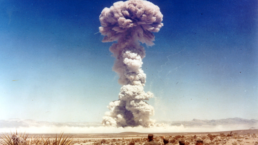The creation of nuclear weapons we see in the Oscar-nominated film isn’t just an issue of the past. We’re still working to avert a nuclear catastrophe.
By Curtis Asplund, The Progressive
As a physicist concerned about nuclear policy, I have been amazed by the success of a three-hour movie about scientists struggling with the creation and consequences of nuclear weapons. “Oppenheimer” is nominated for 13 Academy Awards and is expected to crown its success with a Best Picture win at the Oscars. The film’s story, however, is far from over: Nuclear weapons still threaten us all, and they are a major reason the Doomsday Clock was recently kept at 90 seconds to midnight.

The good news is we can join the efforts of scientists, activists and members of Congress working to avert eventual nuclear catastrophe.
Decades after the Cold War, the United States today still has more than 1,500 nuclear weapons ready to attack, and each weapon is many times more destructive than the bombs dropped on Hiroshima and Nagasaki in 1945, which killed more than 110,000 people. Even a fraction of our arsenal could cause the death of billions of people through nuclear winter and the resulting famine.
To nations around Russia and North Korea, which are threatened by nuclear saber-rattling and missile tests, these weapons are a real and present danger. The nuclear weapons build-up by these nations is profoundly misguided and is making their people less safe, not to mention chewing up money and resources. We should in no way look to them as examples to follow.
Recent Posts
Why Are Democratic Lawmakers Still Meeting With Netanyahu?
July 12, 2025
Take Action Now Pictures show Democrats like Chuck Schumer standing next to Netanyahu, smiling.By Sharon Zhang, Truthout A bipartisan group of…
Stop Israel’s Dystopian “Humanitarian City” Plan—Before It’s Too Late
July 11, 2025
Take Action Now For the past 20 months, the world has watched—and largely enabled—a genocidal campaign in Gaza. Over 55,000 Palestinians have been…
The “Liberal” International Order Is Criminalizing Palestine Protests
July 11, 2025
Take Action Now As Western governments repress Palestine solidarity and enable Israel’s impunity, the “liberal international order” is no longer…
Politicians Are Betraying Gen Z On Climate
July 10, 2025
Take Action Now While Gen-Zers thrift, knit, crochet, and find other ways to reduce our footprints, Trump and the GOP are greenlighting more climate…




